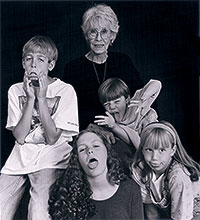Solutions to the Aging Puzzle
By Matt Windsor and Charles Buchanan
 Balance issues, driving troubles, continence problems—whatever their study focus, UAB's geriatric researchers share a common belief: Although aging may be inevitable, the consequences don't have to be. Unfortunately, this is an article of faith that hasn't always been shared by other members of the health-care profession.
Balance issues, driving troubles, continence problems—whatever their study focus, UAB's geriatric researchers share a common belief: Although aging may be inevitable, the consequences don't have to be. Unfortunately, this is an article of faith that hasn't always been shared by other members of the health-care profession.
During the early part of her career in the 1980s, Kathryn Burgio remembers hearing from "many, many patients who had already gone to their doctor" with an incontinence problem and had been rebuffed with a similar line: "Well, what do you expect? You're 83!" The attitude, she says, was that "since there is nothing you can do about getting older, there must be nothing you can do about your bladder."
It's true that, even today, surgical and pharmaceutical treatments for incontinence can be difficult for aging bodies to tolerate. But Burgio has had remarkable success in applying behavioral interventions to the problem—simple, inexpensive therapies such as biofeedback and electrical stimulation that help patients regain control of their bladder muscles. Her team has achieved an 80 percent recovery rate for patients with urinary incontinence; they are now hoping to boost those numbers even more by finding the optimum combination of behavioral, surgical, and medical interventions. "When somebody comes in to our geriatric practice, we're thinking, ‘What is the least invasive treatment we can offer this person?'" says Burgio. "Many older patients are in a delicate balance, so we want to intervene as little as we can."
|
Web Extra: |
The same thing is true for most aging conditions, he notes. "Things are not always what they appear. A daughter may come in with her aging mother and say, ‘Momma's not doing as well as she used to.' And that could mean anything from bacterial sepsis to the loss of a best friend," Allman says.
"Physicians like complexity. They like puzzles. And there is no more complex puzzle than trying to help an older adult remain active and independent in the community."